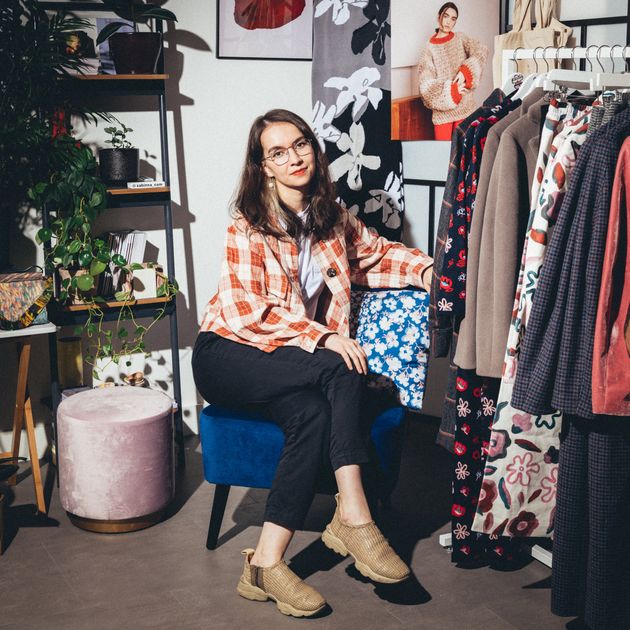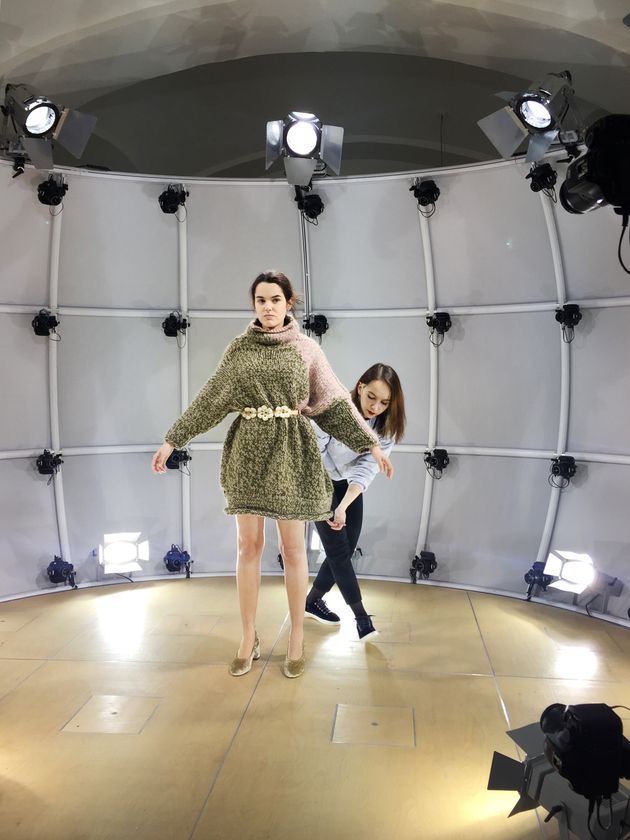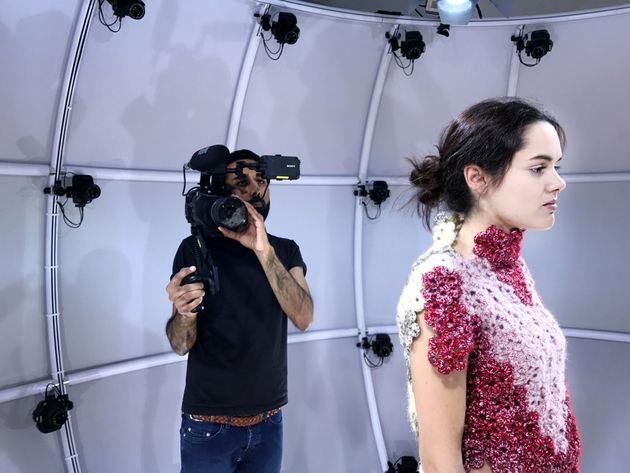Sabinna Rachimova is a designer who’s ahead of the curve when it comes to communicating with her customers and pioneering new ideas, both in terms of her handcrafted-meets-futuristic approach to fashion, and her experimentation with immersive technologies and sales techniques.

The Russian-born, Austrian-raised designer behind the line SABINNA has always been fascinated with creating things with her own hands, and her London-based womenswear label has a strong brand identity centred on storytelling, consciousness, innovating and bringing people together.
The Central Saint Martins grad was taught traditional handcraft techniques from her grandmother years ago, and is passionate about the importance of handicraft in fashion. Handcraft pieces are individualised and made with love, they have an ability to unite people across communities and generations and offer mental health benefits for the crafter, too.
“Handcraft allows you to reconnect with your thoughts and creativity. It’s a therapeutic session. There was a lot of anxiety in lockdown; people had time and had to calm their nerves, and handcraft is beautiful for that. Plus, there’s a sense of accomplishment – you make something and have a final result right away,” Sabinna tells HuffPost UK in a phone interview.
Not only does handcrafting allow for an opportunity to reconnect with yourself and recalibrate your mental health, it also nurtures sustainability.
As Sabinna notes: “People have lost touch with how products are made and what’s behind them. If you understand what’s behind them, the more value you can see in clothes.”
Sabinna is one of three designers participating in a visionary, hyper-immersive virtual fashion show experience on July 29, presented by Verizon’s in-house creative studio, RYOT, along with Charli Cohen and Damara, titled The Fabric of Reality.
While Sabinna’s fashion label is all about the primacy of beautiful handiwork – to connect us with both past and present, to bring individuals together through time and space – the designer is also passionate about how immersive technologies can revolutionise the fashion sphere: ethically, sustainably and creatively.
Sabinna is known for her creative approach to selling and direct communication with her customers, like shaking up how her clothes are presented. She showcased her fourth season collection using Pictofit AR technology on a Microsoft HoloLens, which allowed customers to try on the garments using AR and to switch outfits with a simple hand gesture.

She’s also well versed in how fashion brands can interact and communicate with consumers directly. In pre-pandemic times, the brand hosted a variety of in-store experiences, inviting customers to participate in hand-crafting workshops and to co-design garments in store.
“When lockdown happened, that part of the business had to be rethought as quickly as possible. I’ve always been keen on digital spaces, and always tried to bring innovation where and how we can, so we moved all our workshops and events to digital spaces, and we looked at what the demand is now,” she says.
The pandemic provided the initial inspiration for Sabinna’s The Fabric of Reality fashion project, which she collaborated on with VR designer, Vladimir Ilic, who’s just as keen to explore the relationship between tradition and innovation as she is.
The concept for Sabinna’s virtual story world captures that collective feeling we can all now recognise: the breath of relief when you first step out the door after days, weeks or even longer in isolation.
“Instead of entering, why not exit into a virtual world? Going out is something we’ve all missed,” says Sabinna.
In Sabinna’s story world, everything is handcrafted: objects are stitched, hand-crocheted and hand-knit, with a sculptural, transparent, multi-layered garment at the centre. She used the family archive of original embroideries her grandmother created 30 years ago, which feature the woods and landscapes from central Asia where her granny grew up, to recreate the experience of texture in the virtual world. Sound helps to bring the story to life.
“The sound aspect can make or break this experience, too. Through sound, we manage to give people a feeling of comfort, home, connection and understanding that something has a special meaning. It brings an emotional aspect to visitors of the exhibition.”
Sabinna’s story world theme also asks the viewer to co-create as part of the project, to virtually pin flowers on the garment in whatever pattern they like. Unlike virtual fashion shows that have tried to replicate the physical in the digital realm, the idea behind The Fabric of Reality is about introducing viewers to something they would never be able to experience in person.
“The concept is about how to reconnect with yourself while exiting into a post-pandemic world,” says Sabinna. “It’s built on nature and mindfulness and the idea is that you can interact with things, create prints, add to items and have a full 360-degree experience, rather than just being a viewer of something. It will help you remember the experience on a very different level.”

Inviting the viewer to become a co-creator is about more than enhancing their time in the virtual world – although who isn’t excited about the potential to play designer for an evening? Sabinna feels that the more customers understand what goes into the creativity, design and manufacture of a garment, the more they’ll appreciate how crucial sustainability is to the whole process.
It’s clear the pandemic is already changing how people approach their fashion purchases: they’re buying more for a lifetime rather than a season, and thinking about when they really need a physical product, as well as what makes a product special (and therefore worthy of purchasing). The current crisis has provided an opportunity to shift the focus to what the demand really is, as well as changing our attitudes towards technology – digital means something else now than it did pre-pandemic, and has become something we’ve all become much more comfortable with and conversant in.
“My hope is that after this pandemic fashion will not go back to normal. My hope is that finally this stubborn industry will wake up and create new systems, create new ways to work in a smarter and more inclusive way.
“We can finally bring a new layer to make it more diverse through the digital system. This might not be a popular opinion but there is no going back to Fashion Week the way it used to be – I just don’t see a need for it,” says Sabinna.
For Sabinna, much of the excitement she feels for this project has been bridging the physical and virtual realms, as well as introducing consumers to the possibility of using immersive technologies to help design physical garments. For customers to emerge with their own semi-bespoke creation they can wear in everyday life at the end of this would be the “perfect outcome” in the designer’s mind.
“I get really excited because there are no boundaries and no limits in the virtual world. I don’t have to worry if it fits, if it’s wearable, but I’m excited about how it can be commercially valuable. Fashion is a business, clothes are made to be worn,” she says.
The Fabric Of Reality, presented by RYOT and featuring Sabinna, Damara and Charli Cohen, airs July 29.